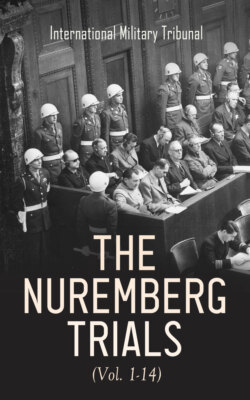Читать книгу The Nuremberg Trials (Vol. 1-14) - International Military Tribunal - Страница 169
THE SA
ОглавлениеStructure and Component Parts: The Prosecution has named Die Sturmabteilungen der Nationalsozialistischen Deutschen Arbeiterpartei (commonly known as the SA) as an organization which should be declared criminal. The SA was founded in 1921 for political purposes. It was organized on military lines. Its members wore their own uniforms and had their own discipline and regulations. After the Nazis had obtained power the SA greatly increased in membership due to the incorporation within it of certain veterans organizations. In April 1933 the Stahlhelm, an organization of 1½ million members, was transferred into the SA, with the exception of its members over 45 years of age and some others, pursuant to an agreement between their leader Seldte and Hitler. Another veterans’ organization, the so-called Kyffhauserbund, was transferred in the same manner, together with a number of rural riding organizations.
Until 1933, there is no question but that membership in the SA was voluntary. After 1933 civil servants were under certain political and economic pressure to join the SA. Members of the Stahlhelm, the Kyffhauserbund, and the rural riding associations were transferred into the SA without their knowledge, but the Tribunal is not satisfied that the members in general endeavored to protest against this transfer or that there was any evidence, except in isolated cases, of the consequences of refusal. The Tribunal therefore finds that membership in the SA was generally voluntary.
By the end of 1933 the SA was composed of 4½ million men. As a result of changes made after 1934, in 1939 the SA numbered 1½ million men.
Activities: In the early days of the Nazi movement the storm troopers of the SA acted as the “strong arm of the Party”. They took part in the beer hall feuds and were used for street-fighting in battles against political opponents. The SA was also used to disseminate Nazi ideology and propaganda and placed particular emphasis on anti-Semitic propaganda, the doctrine of “Lebensraum”, the revision of the Versailles Treaty, and the return of Germany’s colonies.
After the Nazi advent to power, and particularly after the elections of 5 March 1933, the SA played an important role in establishing a Nazi reign of terror over Germany. The SA was involved in outbreaks of violence against the Jews and was used to arrest political opponents and to guard concentration camps, where they subjected their prisoners to brutal mistreatment.
On 30 June and 1 and 2 July 1934 a purge of SA leaders occurred. The pretext which was given for this purge, which involved the killing of Röhm, the Chief of Staff of the SA, and many other SA leaders, was the existence of a plot against Hitler. This purge resulted in a great reduction in the influence and power of the SA. After 1934, it rapidly declined in political significance.
After 1934 the SA engaged in certain forms of military or para-military training. The SA continued to engage in the dissemination of Nazi propaganda. Isolated units of the SA were even involved in the steps leading up to aggressive war and in the commission of War Crimes and Crimes against Humanity. SA units were among the first in the occupation of Austria in March 1938. The SA supplied many of the men and a large part of the equipment which composed the Sudeten Free Corps of Henlein, although it appears that the corps was under the jurisdiction of SS during its operation in Czechoslovakia.
After the occupation of Poland, the SA group Sudeten was used for transporting prisoners of war. Units of the SA were employed in the guarding of prisoners in Danzig, Posen, Silesia, and the Baltic States.
Some SA units were used to blow up synagogues in the Jewish pogrom of 10 and 11 November 1938. Groups of the SA were concerned in the ill-treatment of Jews in the ghettos of Vilna and Kaunas.
Conclusion
Until the purge beginning on 30 June 1934, the SA was a group composed in large part of ruffians and bullies who participated in the Nazi outrages of that period. It has not been shown, however, that these atrocities were part of a specific plan to wage aggressive war, and the Tribunal therefore cannot hold that these activities were criminal under the Charter. After the purge, the SA was reduced to the status of a group of unimportant Nazi hangers-on. Although in specific instances some units of the SA were used for the commission of War Crimes and Crimes against Humanity, it cannot be said that its members generally participated in or even knew of the criminal acts. For these reasons the Tribunal does not declare the SA to be a criminal organization within the meaning of Article 9 of the Charter.
